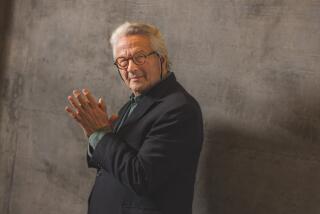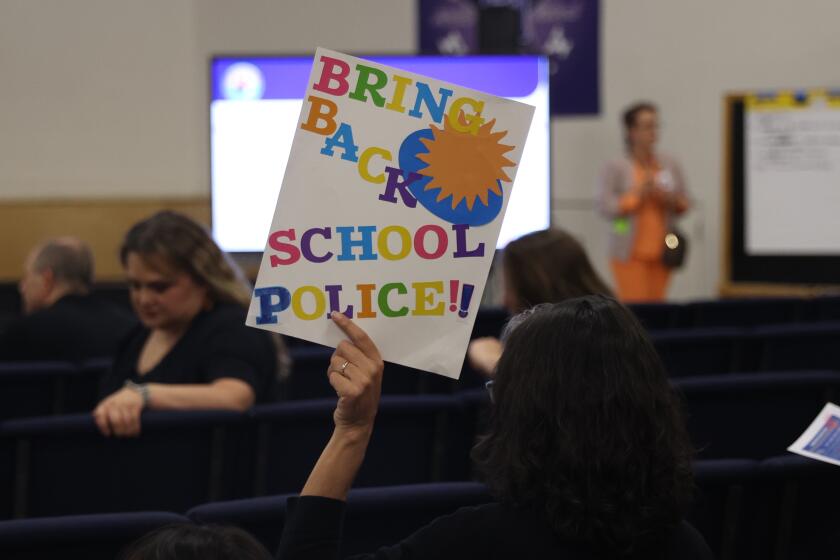Pop Torts 101
For most of their law school careers, the students in professors Michael Asimow and Paul Bergman’s class have studied subjects like constitutional and commercial law. Today, however, they’re tackling something different--Tom Cruise and Cher.
In “Law and Popular Culture,” a weekly, three-unit elective course at UCLA, students use film, television and literature to help examine the role that the law plays in popular culture and vice versa. Throughout the semester, students will take up topics like the criminal justice system and legal ethics--using the shows to foster discussion.
UCLA Law, meet “L.A. Law.”
Works to be studied include movies such as “To Kill a Mockingbird,” “Jagged Edge,” “Philadelphia,” “Judgment at Nuremberg,” “The Paper Chase,” “Bonfire of the Vanities,” “Primal Fear” and “Adam’s Rib,” TV shows including “Perry Mason” and “Matlock,” and books such as John Grisham’s “The Rainmaker” and Scott Turow’s “One-L.”
“A lot of people’s attitudes toward lawyers . . . are shaped by what they’ve read, what they’ve seen on television, what they see in the movies,” Bergman says. “It’s interesting to look in some systematic way at this popular culture.” Adds Asimow, “There’s always been a premium here on innovation and trying to do things that are different.”
Asimow and Bergman consider this course an “experiment.” Inspired by a book the professors co-authored, “Reel Justice: The Courtroom Goes to the Movies,” the two aren’t sure what to expect from the class. They do know, though, that despite the seemingly light nature of the topic, this class is no joke. Not only do students have to write a 20- to 25-page term paper, they also must pair up into teams and teach the two-hour, 15-person class once during the semester.
“We’re taking the subject seriously,” Asimow says. “We’re not treating it as froufrou.
“Mostly I’ve taught subjects in which I’m an expert . . . where there’s obviously a big gulf between the students and me,” Asimow adds. “I don’t feel like I have a unique expertise here. . . . That’s why after the first week or two we’re going to have the students lead the discussion rather than us.”
Each professor approaches the course from a different angle. Asimow looks at the material in more of a theoretical way: How are law and pop culture intertwined? How are lawyers portrayed? Bergman takes a more practical perspective. He asks students to put themselves in the role of the character.
“In most of the law classes you can kind of put your mind in a narrow track and say, ‘OK, I’m only going to be talking about contract problems,’ ” Bergman says. “When you look at a movie, it can raise a number of different kinds of legal issues. It can raise ethical issues. It could raise personal problems for the lawyer. All of these things swirling in the same scenario is much more realistic to practice. . . . We want students to see how these problems interrelate.”
On this day the class is getting a lesson about legal life. Before class, students were supposed to watch “Counsellor at Law,” a 1933 film that tells the story of, among other things, a workaholic attorney played by John Barrymore. In “Counsellor,” Barrymore’s Jewish character not only has troubles dealing with prejudice in the workplace, but also discovers that his wife has cheated on him. For more perspective on workaholism, the professors show back-to-back clips from “The Firm” and “Suspect.”
Having just watched a scene from Cruise’s “The Firm,” in which the actor throws himself into his work, the students are now watching Cher’s “Suspect.”
“I don’t have a life,” says Cher’s character. “I spend all my time with murderers and rapists. . . . I don’t think I can do it anymore.”
“Do these characters seem real to you?” Bergman asks.
A curly-haired woman raises her hand. “Someone did a bad makeup job. . . . Cher didn’t look tired.” Everyone laughs.
After class, second-year law student Mark Greenstone says that the course offers a “nice break” from the case-intensive classes he generally takes. “It’s much different than any other course in law school,” says Greenstone, 27. He notes that although the class watches a lot of movies and they study from a book showing a bare-midriffed Geena Davis on the cover, there is real work involved.
Cathy Sun, 28, concurs. In preparing for co-leading the class on the subject of vigilante justice, the second-year law student watched eight hours’ worth of films and devoted an entire weekend to the presentation.
On the first day of class, the professors asked students to write down why they were taking the course. Never having taught “Law and Popular Culture” before, Asimow was especially curious as to how the students would respond. He received a variety of replies.
“Some of them are interested in the media or hope to practice entertainment law,” Asimow says. “Or they’re interested in how lawyers have been shown in the media so that they can better relate to nonlawyers. . . . And a lot of them thought it would be fun, which is fine. I think people should have fun in all their classes.”
More to Read
The biggest entertainment stories
Get our big stories about Hollywood, film, television, music, arts, culture and more right in your inbox as soon as they publish.
You may occasionally receive promotional content from the Los Angeles Times.






